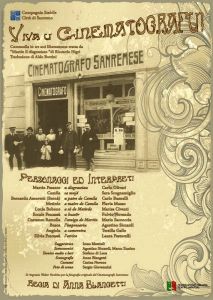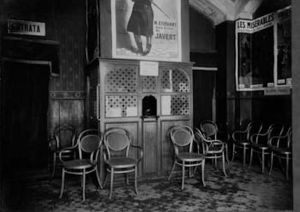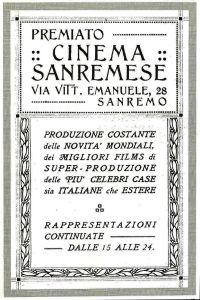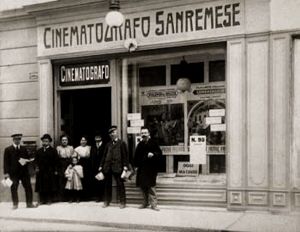The Cinema Sanremese.

 Carlo Vacchino, with his wife Emilia Accatino, began his entrepreneurial activity in the field of entertainment in 1908, taking over the cinema in Via Vittorio Emanuele II, called "The American Cinematograph", renaming it "Cinematografo Sanremese", the first cinematograph in the city which had been inaugurated only two years earlier.
Carlo Vacchino, with his wife Emilia Accatino, began his entrepreneurial activity in the field of entertainment in 1908, taking over the cinema in Via Vittorio Emanuele II, called "The American Cinematograph", renaming it "Cinematografo Sanremese", the first cinematograph in the city which had been inaugurated only two years earlier.
Located on the ground floor, the premises had two hundred seats, a large waiting room, a convenient entrance and a luminous window, where programmes supplied exclusively by the Pathé Consortium were displayed.
For the film business, Carlo collaborated with film distributor Stefano Pittaluga, an enlightened Ligurian film pioneer.
 Personal testimony:
Personal testimony:
".......Ed here is the wide entrance of the old Cinema Sanremese where Carlo Vacchino, Carla and Walter's grandfather, coming from Genoa, started his activity in Sanremo as manager of theatre and cinema shows.
The emergency exits of the long and narrow projection room overlooked, as it still does today, Via Volturno and, more than once, when we were young, we used to sneak quickly through these exits into the room crammed like an egg, eluding the even careful surveillance of old Liberato, when between one show and another he would open them to air the room, when the air conditioning systems were still to come. We were, however, of modest pretensions and went to occupy, when we found them, the first rows of the third seats, right under the screen and we got a stiff neck with our heads turned upwards to follow the sequences of the film, sometimes still silent, accompanied only by the notes of the pianist who, with skill and timing, synchronised them with the images, which to us appeared distorted and stretched out of proportion, from bottom to top, as happens to our figure when it is reflected in deforming mirrors.
We were, however, of modest pretensions and went to occupy, when we found them, the first rows of the third seats, right under the screen and we got a stiff neck with our heads turned upwards to follow the sequences of the film, sometimes still silent, accompanied only by the notes of the pianist who, with skill and timing, synchronised them with the images, which to us appeared distorted and stretched out of proportion, from bottom to top, as happens to our figure when it is reflected in deforming mirrors.  We could also have sneaked into the first seats, characterised by folding armchairs covered in red velvet, but we were content with the "thirds", also because, when the lights came on between one time and another, our group of "Portuguese" (scroungers) would have been immediately identified by the ushers, who were able, with a glance, to assign each spectator in the room the right place.
We could also have sneaked into the first seats, characterised by folding armchairs covered in red velvet, but we were content with the "thirds", also because, when the lights came on between one time and another, our group of "Portuguese" (scroungers) would have been immediately identified by the ushers, who were able, with a glance, to assign each spectator in the room the right place.
 It was then a heroic era for the cinema, when television was still at the design stage and the noble art of the Lumiére brothers had nothing to fear from it.
It was then a heroic era for the cinema, when television was still at the design stage and the noble art of the Lumiére brothers had nothing to fear from it.
Being able to get into one of the few theatres available at that time, especially on holidays, was a rather difficult task and, if this happened, most of the time you had to be content to follow the events of the film for almost the entire time standing up, so crowded was the crowd.
Let's not talk about when dramas such as Ben Hur, the first of the series starring the charming Ramon Navarro, the White Nun, the Sign of the Cross, Les Miserables or, in more recent times, giants such as Gone with the Wind were shown.
The real "fiction", so much vaunted today, was that of that time when, after crying for almost the entire duration of the tear-jerking show, people, especially the fairer sex, would come out pressing a handkerchief over their eyes and, blowing their noses, would exclaim in a voice broken by emotion: "What a beautiful film! How much fun I had!!!"
(sources: elaboration from " C'era una volta la Via Vittorio " by Cesare Gentili and from the book "Sanremo e l'Europa, l'Immagine della Città tra Otto e Novecento" edited by Letizia Lodi; ediz. Scalpendi, 2018; images from Private Archive)




